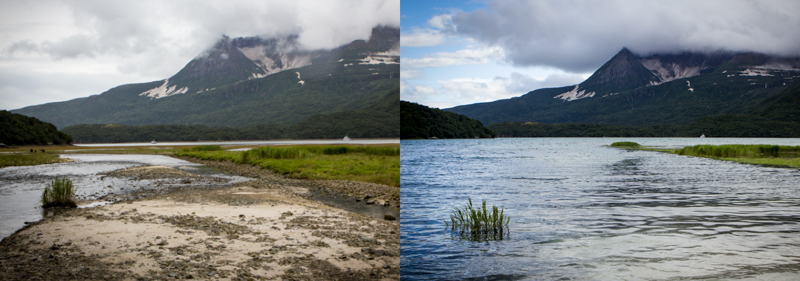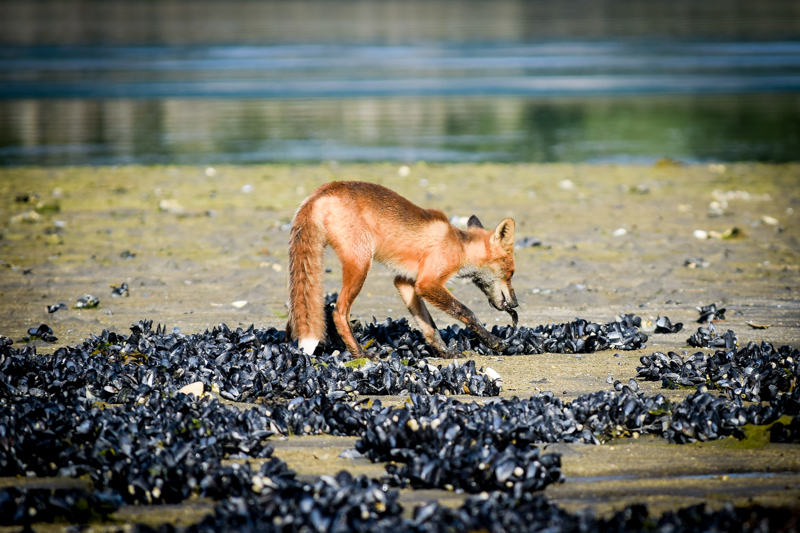
Mountains and waterfalls surround Amalik Bay. NPS Photo/D. Kopshever.
Amalik Bay is a world of contrast. Vibrant green islands and bursting waterfalls reminiscent of a tropical paradise clash with bitter rain and gusts of wind at a moments notice. Spiring cliffs rise 3,000 feet from the ocean and into the clouds. At the base of these ocean cliffs, waist deep water stretches for nearly a mile before dropping off to deeper depths. Throughout Amalik Bay, the extremes of nature are present.
At low tide, the shallow water recedes to reveal vast tidal flats. What were small islands at high tide become extensions of the mainland, revealing intricate tide pools and fields of mussels and clams. As the tide goes out, a smorgasbord of food is made available, and lanes of travel open up for land dwelling animals.

A comparison of low tide vs. high tide at the mouth of Geographic Creek. NPS Photo/D. Kopshever.
Along the Brooks River, salmon are the lifeblood of the ecosystem. Here, in Amalik Bay, tides dictate the way of life for all animals along the coast. Each day, a feast of the ocean’s bounty is offered to creatures not built for the world of the sea. This abundance, however, is temporary; in just a few hours, the ocean returns to claim its gifts of life. The animals that depend on them must act quickly to take advantage of a short window of opportunity.
During these brief and essential periods of low tide, bears, wolves and foxes peruse the open beach for an easy meal. They may find the washed up carcass of a flounder, sea otter, or even a humpbacked whale. Gulls and shorebirds, too, fly the coastline looking for marine carrion. While on the lookout for such meals, bears pick through a cafeteria of clams, mussels, and barnacles.
 A Bear digs for clams in the intertidal zone. NPS Photo/D. Kopshever.
A Bear digs for clams in the intertidal zone. NPS Photo/D. Kopshever.
Like fishing for salmon, bears use different techniques for penetrating the armor of shellfish. Clams must first be sniffed out and dug up from beneath the sand. Some bears use their strong shoulder muscles to stomp and crush the shell, while others delicately pick the clam apart with claws, while still others use powerful jaws to crack open the tightly sealed clam. Some bears have learned to smear barnacles against the rocks with an open paw, then lick up the exposed snail-like animal, like a salty jell-o snack from the sea.
Mussels are abundant during low tide and are easier to break into, making an excellent meal for both bears and smaller predators like foxes and wolves. Sand lance, sculpin and other small fish can also be trapped by the tide, becoming a bite-sized snack for the fox.
 A red fox picks a small fish from the sand. NPS Photo/M. Cohn.
A red fox picks a small fish from the sand. NPS Photo/M. Cohn.
Bears, however, have larger appetites. Salmon spawn here, too, and the opportunistic brown bear capitalizes. After feasting on shellfish and whatever else is trapped by the low tide, bears move to various creek mouths to intercept salmon riding in the high tide on their migration to spawn.
Coastal brown bears are solitary animals. A wider variety of available marine food sources and a more open, unconfined terrain allow these bears the space and seclusion they prefer. Still, the biological drive to consume enough food to survive the long winter ahead is strong enough to compel many bears to congregate at predictably productive salmon streams. Five to ten bears can regularly be seen within a mile of Geographic Creek, the largest freshwater inlet into the bay, fishing for chum, pink, and silver salmon.
 A bear cub runs through the river with a salmon head in its mouth. NPS Photo/D. Kopshever.
A bear cub runs through the river with a salmon head in its mouth. NPS Photo/D. Kopshever.
Salmon are an extremely important food source for these coastal brown bears, but they do not depend on them in the same way the bears of Brooks River do. If the sockeye salmon run were to suddenly fail, many of the bears we have come to know would not survive. Here, in Amalik Bay and all along the coast of Katmai, a different breed of brown bear exists. Like the inland brown bear, the coastal brown bear is defined by its environment, and adapts accordingly.
Every day, the tide comes in and forces land dwelling animals to walk more confined lanes of travel and search for more meager meals among thick alders and sharp ocean cliffs. The changing tide, predictably and constantly altering that thin margin between land and sea, is the key force that bears and many other coastal animals depend on for survival in the wild. They eat, sleep and travel according to its cycle, and with our protection of the ecosystem, they will continue to make a living with the changing tides of Katmai.
